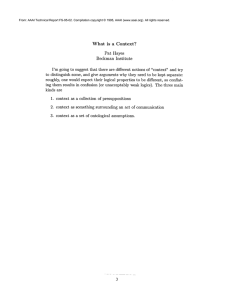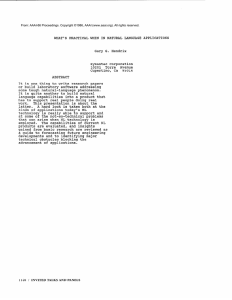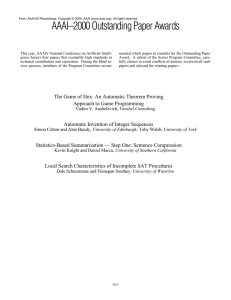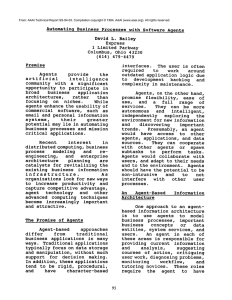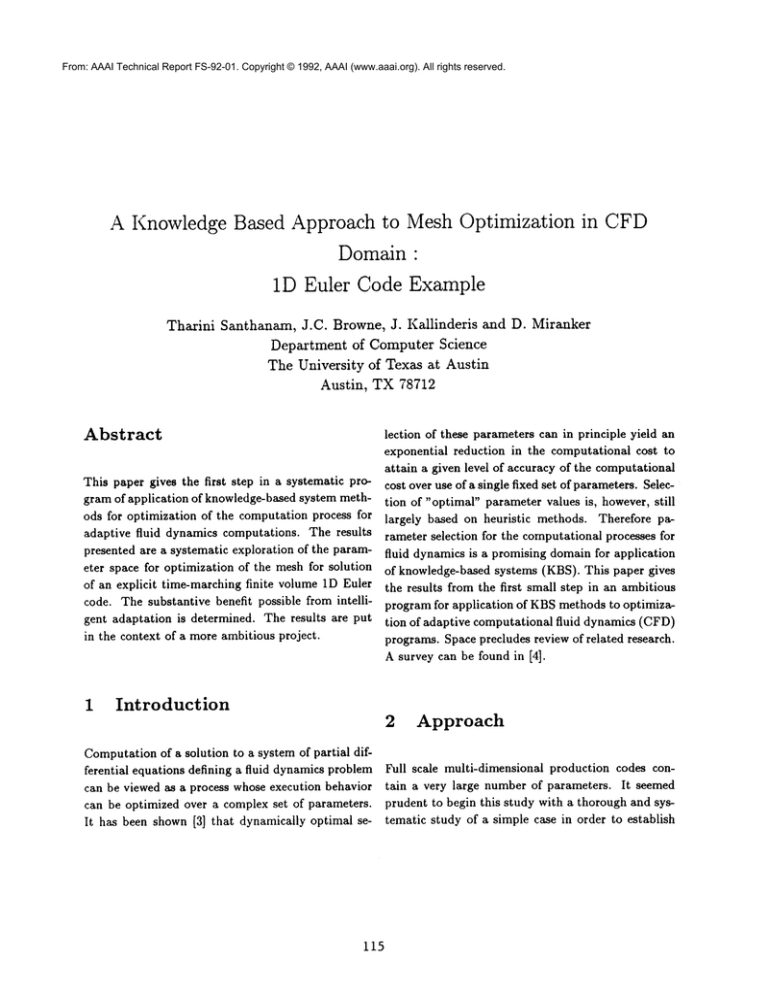
From: AAAI Technical Report FS-92-01. Copyright © 1992, AAAI (www.aaai.org). All rights reserved.
A Knowledge Based Approach to Mesh Optimization in CFD
Domain:
ID Euler Code Example
Tharini
Santhanam,
J.C.
Browne, J. Kallinderis
and D. Miranker
Department
of Computer Science
The University
of Texas at Austin
Austin,
TX 78712
lection of these parameters can in principle yield an
exponential reduction in the computational cost to
attain a given level of accuracy of the computational
Thispapergivesthefirststepin a systematic
pro- cost over use of a single fixed set of parameters. Selecgram of application of knowledge-based system meth- tion of "optimal" parameter values is, however, still
ods for optimization of the computation process for largely based on heuristic methods. Therefore paadaptive fluid dynamics computations. The results
rameter selection for the computational processes for
presented are a systematic exploration of the param- fluid dynamics is a promising domain for application
eter space for optimization of the mesh for solution of knowledge-based systems (KBS). This paper gives
of an explicit time-marching finite volume 1D Euler the results from the first small step in an ambitious
code. The substantive benefit possible from intelliprogram for application of KBSmethods to optimizagent adaptation is determined. The results are put tion of adaptive computational fluid dynamics (CFD)
in the context of a more ambitious project.
programs. Space precludes review of related research.
A survey can be found in [4].
Abstract
1
Introduction
2
Computation of a solution to a system of partial differential equations defining a fluid dynamics problem
can be viewed as a process whose execution behavior
can be optimized over a complex set of parameters.
It has been shown [3] that dynamically optimal se-
Approach
Full scale multi-dimensional production codes contain a very large number of parameters. It seemed
prudent to begin this study with a thorough and systematic study of a simple case in order to establish
115
From: AAAI Technical Report FS-92-01. Copyright © 1992, AAAI (www.aaai.org). All rights reserved.
an infrastructure for study of the more complex systems, to evaluate the practicality of the approach and
to determine howmuch of the potential impact of optimization can be readily realized with a straightforward approach.
The simple case of an explicit time-marching finite
volume 1D Euler code which restricts
adaptation to
only the meshsize was chosen as the first system for
study.
The system of the one-dimensional Euler equations
of inviscid fluid flow maybe written in cartesian coordinates conservation form as :
OU
OF
07 + = o
(1)
where
U
pu
E
, F=
pu2 + p
(E + p)u
for example shocks and stagnation regions). Initial
coarse grid-cells are divided by inserting additional
points inbetween the initial points, thus creating a
local embeddedgrid. Conversely, excessive resolution
is removedby deleting grid-points locally over regions
in which the solution does not vary appreciably.
This code was found to have five parameters which
may exercise significant
impact on computational
cost. Formulation of the knowledge base for the 1D
code was done primarily by interviews with the authors of the code, Y. Kallinderis (one of the authors
of this paper) and A. Vidwans. The five parameters
identified were: (i) the solution property to be used
to invoke mesh adaptation (the detection parameter),
(ii) the threshold for the detection parameter for initiating cell division, (iii) the threshold for the detection parameter for initiating cell coalescence, (iv)
the interval between evaluations of the detection parameter (frequency of adaptation) and (v) the initial
mesh. Another possible parameter is the factor by
which mesh size is divided or multiplied when a cell
division or coalescence is carried out. This was set to
two for these studies. Yet another possible parameter
is the size of the time step. The time step was not
varied but instead was set to 1 for these experiments.
are the state and flux vectors respectively. In the
above relations p is density, u is velocity, E is total
internal energy per unit volume, and p is pressure. A
one-step Lax-Wendroff-type integration scheme [1, 2] Parameter selection and binding can be done at sevhas been employed.
eral times. Certain parameters can be determined at
the time of design of the code from the characterisA typical use of this code might be to study the prop- tics of the physical system being modeled. This is the
agation of perturbations in a uniform field.
case for the detection parameter. (The detection parameter will normally be an estimator for the error in
Grid adaptation consists of adjusting the grid spac- the computedsolution.) The flow is supersonic, invising so that the numerical error is relatively small and cid and compressible. This set of conditions leads to
equally distributed throughout the solution domain. the selection of the velocity difference between mesh
This is accomplishedby increasing grid resolution lo- points as the detection parameter. Certain paramecally in regions in which flow features exist(i.e, re- ters should be reasonably constant across the problem
gions where changes in flow-field quantities are large,
116
From: AAAI Technical Report FS-92-01. Copyright © 1992, AAAI (www.aaai.org). All rights reserved.
set to which the code applies. These can be selected
by executing the code for a span of parameter values and choosing a single "near optimal" value. The
initial meshand the threshold coefficients of the detection values for cell division and coalescence are
examples. There are two modes of selecting a near
optimal mesh. The code can be executed with an
initial mesh with the detection parameter evaluated
at each mesh point. The resulting values for the detection parameter can then be used to construct a
near optimal mesh for a final evaluation. The other
approach is to dynamically adapt the mesh as the
code is executing using the values of the frequency
and thresholds to minimize the total execution cost
of the computation. The latter approach is used in
this study.
effect of the frequency of adaptation on the number
of iterations to convergence. There is a minimumat
an interval of seventy steps. (It is interesting to note
that the initial selection by the "experts" for the code
was 50 steps.) Figures 2 and 3 show the effect of the
thresholds for cell division and cell coalescence on the
number of iterations to convergence. There are clear
minima at 1.4 and 0.9. (The actual thresholds are the
products of these constants with the average value of
the velocity difference between mesh points.) Figure
4 is a plot of numberof iterations before convergence
as a function of the number on nodes in the initial
mesh. The interpretation of this graph requires the
additional information of what is the coarsest mesh
which does not result in the loss of flow features in
the resulting solution. An initial meshof at least 31
points is required to insure capture of flow features.
The knowledge-based system is formulated in terms Figures 5,6,7 and 8 show the solution and the mesh
of production rules and encoded in the ’C’ Language ( plotted as a series of straight lines at the bottom
Integrated Production System (CLIPS) [5]. CLIPS of the figures) at several successive points in time
was chosen as the programming vehicle because it for the propagation of an initial triangle-shaped percompiles to C and thus both gives reasonable perfor- turbation in a uniform one-dimensional field. Note
mance and is readily interfaced to Fortran which is how the mesh is successively refined and coarsened
the dominant language for CFDcomputations.
as the solution features evolves across the spacial coordinate.
3
Results
The direct results reported are the optimal values for
the four parameters, an assessment of the infrastructure for more extensive studies such as the feasibility
of rule embedding in Fortran programs.
Figures 1,2,3 and 4 are examples of parameter selection experiments. The metric of goodness for selection is the number of iterations required to converge
the solution to a target accuracy. Figure 1 shows the
117
A significant portion of the research so far has been
to set up the framework for study of more complex
systems. The actual programming of the knowledge
base in the work to date could easily have been done
in Fortran or C. The exercise of working in a formal
rule-based language system has demonstrated the feasibility of working on more complex systems.
From: AAAI Technical Report FS-92-01. Copyright © 1992, AAAI (www.aaai.org). All rights reserved.
4
Comment and Future
Work
Another goal is to determine the transferability
of
knowledge across problems. There will be a further
series of experiments on the 1D code to define the robustness of the knowldge base across the problem set
reachable with this code. Wewill report at the the
Workshopon the span of applicability of the knowledge gained in these studies.
The next step in this project after completing the
analyses for the 1D Euler code is to formulate and
apply a knowledge-base for a more complex problem structure aa implemented in a 2D finite element
Navier-Stokes code which includes both mesh optimization and approximation function optimization.
The long term goals include development of a programming environment for CFDcodes which will facilitate formulation and implementation of intelligent
adaptive CFDcodes.
5
Acknowledgements
This research has been supported by the IBMCorporation through grant number 61653 and by the
National Science Foundation through grant number
ASC-9111540.
References
and J. R. Baron "Adaptation
[1] Y. Kallinderis,
Methods for a New Navier-Stokes Algorithm,"
Journal of the American Institute of Aeronau-
118
tics and Astronautics, vol. 27 , no. 1 , pp 37-43
,1989.
"Adaptation Methods for Vis[2] Y. Kallinderis,
cous Flows," Ph.D. Thesis, MIT, Dept. of Aeronautics and Astronautics, CFDL-TR-89-5, May
1989.
[3] J.T. Oden - Private
Communication.
[4] Tharini Santhanam, J.C. Browne "A Knowledge Based System for CFD" Technical Report,
Department of Computer Sciences, UT Austin,
1992.
[51CLIPSVersion5.1 ReferenceManual,Software
TechnologyBranch,NASA JohnsonSpaceCenter,October
1991.
From: AAAI Technical Report FS-92-01. Copyright © 1992, AAAI (www.aaai.org). All rights reserved.
Figure 1: Numberof iterations before convergence
versus Frequency of Adaptation
Effect
of Change
m~mab~~ t mmmt~asbs~sms o~l,mqlamml
in
Thrmhold
for
Figure 3: Numberof iterations before convergence
versus Threshold for Cell Deletion
Division
N,a~bmr
i .4ft~~’~
EFFect
of Change
in Initial
ed t~ ~st~ ~,~rDmm~ z ¯to
~
~
’
Grid
’
SIz*
’
’
¯ 05J
,OC
s~.oo
sl~.oo
.94]
72o.~
¯ 75 -.70
6~10.oo
i~o.oo
s~o.oo
$,1.0.0~
I
I
I
t
1.6o
.--
I
1.8o
Figure 2: Numberof iterations before convergence
versus Thresholdfor Cell Division
119
I__
IO.l~
n
20.00
I
30.00
I
40.00
I
~lO.~O0
I
~lO.IlO
I
70.00
Figure 4: Numberof iterations before convergence
versus Numberof Initial nodes
From: AAAI Technical Report FS-92-01. Copyright © 1992, AAAI (www.aaai.org). All rights reserved.
Ell II II II I lblL II1II III II II I llLIIIIII
Figure 5: Propagation of solution perturbation and Figure 7: Propagation of solution perturbation and
corresponding adapted grid
corresponding adapted grid
I I rll IllIitIllrPIIfPIIlllIII lit III111tIXlIPIIrll|
Figure 6: Propagation of solution perturbation and Figure 8: Propagation of solution perturbation and
corresponding adapted grid
corresponding adapted grid
120

